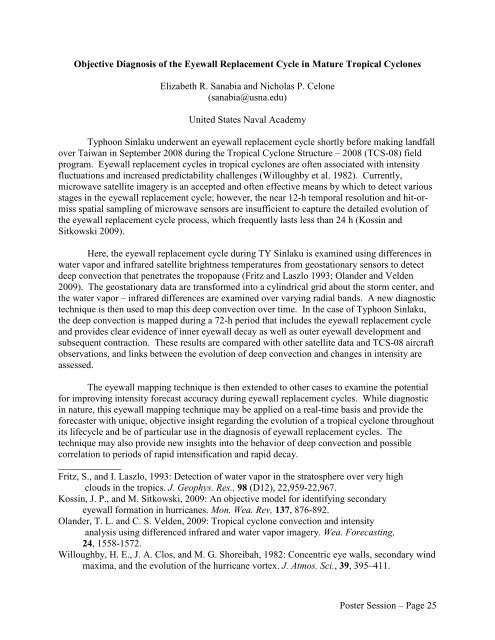65th IHC Booklet/Program (pdf - 4.9MB) - Office of the Federal ...
65th IHC Booklet/Program (pdf - 4.9MB) - Office of the Federal ...
65th IHC Booklet/Program (pdf - 4.9MB) - Office of the Federal ...
Create successful ePaper yourself
Turn your PDF publications into a flip-book with our unique Google optimized e-Paper software.
Objective Diagnosis <strong>of</strong> <strong>the</strong> Eyewall Replacement Cycle in Mature Tropical Cyclones<br />
Elizabeth R. Sanabia and Nicholas P. Celone<br />
(sanabia@usna.edu)<br />
United States Naval Academy<br />
Typhoon Sinlaku underwent an eyewall replacement cycle shortly before making landfall<br />
over Taiwan in September 2008 during <strong>the</strong> Tropical Cyclone Structure – 2008 (TCS-08) field<br />
program. Eyewall replacement cycles in tropical cyclones are <strong>of</strong>ten associated with intensity<br />
fluctuations and increased predictability challenges (Willoughby et al. 1982). Currently,<br />
microwave satellite imagery is an accepted and <strong>of</strong>ten effective means by which to detect various<br />
stages in <strong>the</strong> eyewall replacement cycle; however, <strong>the</strong> near 12-h temporal resolution and hit-ormiss<br />
spatial sampling <strong>of</strong> microwave sensors are insufficient to capture <strong>the</strong> detailed evolution <strong>of</strong><br />
<strong>the</strong> eyewall replacement cycle process, which frequently lasts less than 24 h (Kossin and<br />
Sitkowski 2009).<br />
Here, <strong>the</strong> eyewall replacement cycle during TY Sinlaku is examined using differences in<br />
water vapor and infrared satellite brightness temperatures from geostationary sensors to detect<br />
deep convection that penetrates <strong>the</strong> tropopause (Fritz and Laszlo 1993; Olander and Velden<br />
2009). The geostationary data are transformed into a cylindrical grid about <strong>the</strong> storm center, and<br />
<strong>the</strong> water vapor – infrared differences are examined over varying radial bands. A new diagnostic<br />
technique is <strong>the</strong>n used to map this deep convection over time. In <strong>the</strong> case <strong>of</strong> Typhoon Sinlaku,<br />
<strong>the</strong> deep convection is mapped during a 72-h period that includes <strong>the</strong> eyewall replacement cycle<br />
and provides clear evidence <strong>of</strong> inner eyewall decay as well as outer eyewall development and<br />
subsequent contraction. These results are compared with o<strong>the</strong>r satellite data and TCS-08 aircraft<br />
observations, and links between <strong>the</strong> evolution <strong>of</strong> deep convection and changes in intensity are<br />
assessed.<br />
The eyewall mapping technique is <strong>the</strong>n extended to o<strong>the</strong>r cases to examine <strong>the</strong> potential<br />
for improving intensity forecast accuracy during eyewall replacement cycles. While diagnostic<br />
in nature, this eyewall mapping technique may be applied on a real-time basis and provide <strong>the</strong><br />
forecaster with unique, objective insight regarding <strong>the</strong> evolution <strong>of</strong> a tropical cyclone throughout<br />
its lifecycle and be <strong>of</strong> particular use in <strong>the</strong> diagnosis <strong>of</strong> eyewall replacement cycles. The<br />
technique may also provide new insights into <strong>the</strong> behavior <strong>of</strong> deep convection and possible<br />
correlation to periods <strong>of</strong> rapid intensification and rapid decay.<br />
_____________<br />
Fritz, S., and I. Laszlo, 1993: Detection <strong>of</strong> water vapor in <strong>the</strong> stratosphere over very high<br />
clouds in <strong>the</strong> tropics. J. Geophys. Res., 98 (D12), 22,959-22,967.<br />
Kossin, J. P., and M. Sitkowski, 2009: An objective model for identifying secondary<br />
eyewall formation in hurricanes. Mon. Wea. Rev, 137, 876-892.<br />
Olander, T. L. and C. S. Velden, 2009: Tropical cyclone convection and intensity<br />
analysis using differenced infrared and water vapor imagery. Wea. Forecasting,<br />
24, 1558-1572.<br />
Willoughby, H. E., J. A. Clos, and M. G. Shoreibah, 1982: Concentric eye walls, secondary wind<br />
maxima, and <strong>the</strong> evolution <strong>of</strong> <strong>the</strong> hurricane vortex. J. Atmos. Sci., 39, 395–411.<br />
Poster Session – Page 25
















